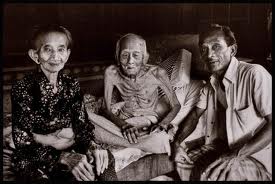Thirty six years after his death at the age of 116, the first complete presentation of the works of I Gusti Nyoman Lempad is now available. On June 19th 2014 at Arma Museum in Ubud, the book was formally launched. Edited by Ana Gasper and Antonio Casanovas with ‘Pictures Publishers’ of the Netherlands, it is the first meaningful catalogue and biography of the most famous Balinese artist. The 300 page tome is a complete presentation of Lempad’s work; biography, social and cultural environment, all accompanied by rich illustrations. The book launch included among its honoured guests, prominent members of Ubud’s royal family. The Ubud palace was Lempad’s foremost patron. The guests were addressed by one of Indonesia’s most influential literary icons Goenawan Mohamad.
The book is the result of seven years of work to produce a definitive book on this unique artist. Ana and Antonio were mesmerized by the works of Lempad when they first saw his drawings at Neka Museum two decades ago. They searched for books on him to no avail. The project has taken them all over the world, looking for the art of the most distinguished artist of Bali whose works were carried and shown abroad as early as the 1930s. They collaborated with author Jean Cocteau, an expert on Balinese art who has written several books and essays on various artists of Bali.
Born sometime after the mid-nineteenth century, Lempad started his work as a Balinese Undagi (master architect builder) and a Sanging (religious artist). These works integrated the coded knowledge of architecture, art, religion, and sacred formulations; of space and the relation of the human body to that space, iconography and mythologies of the culture. His works included traditional sculptures of temple statues, masks, wayang puppets, cremation towers, sarcophagi and nagas. Identifying some of his creations is complicated as he never signed his works. Any ‘signed’ were done so by family members to write the title and artist acknowledgement. The most reliable source for Lempad was his son, I Gusti Made Sumung who worked with John Darling and Lorne Blair on an award-winning documentary which tells the story of the artist at the end of his life and films his cremation. The documentary is titled ‘Lempad of Bali’ (1980).

Lempad built most of the temples and palaces in Ubud and its neighbouring villages. His exact birthday is unknown, but we know he was married when Krakatau went off in 1883. When he died on April 25th in 1978, he gathered his family around him and asked them to bathe him and then died. The Balinese said he chose the most auspicious holy time to pass on, surrounded by his loved ones.
He maintained close friendships with Rudolf Bonnet and Walter Spies. Lempad is most famous internationally for his drawings done after 1925 after meeting Walter Spies, who provided him with paper and materials and most likely introduced him to other illustrators’ works. He continued to draw in black and white through the Great War, the Indonesian struggle for independence, and post independence, until his death. He never compromised his distinctive identity as a Balinese artist. He is a bridge between traditional and modern art. Lempad’s art is beyond influence. His drawings are not limited to one style, although his ‘lines’ are identifiable; his styles vary from traditional to surreal, to simple depictions of everyday life. He drew history, all the while continuing his tradition as artist, architect and sculptor for the House of Sukawati in Ubud.
Lempad, a Timeless Balinese Master is available at Periplus bookstores. For other locations, contact www.picturespublishers.nl.




